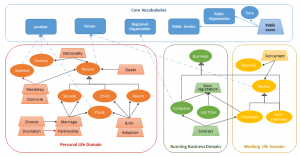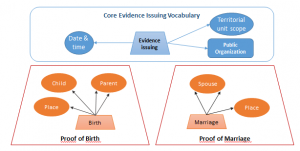Difference between revisions of "Canonical Evidence"
m (Minor typos) |
m (Minor edits) |
||
| Line 1: | Line 1: | ||
| − | '''Canonical Evidence''' is the ''canonical form of a domestic evidence according to a common data structure and format''. DE4A has defined a canonical form for each of the evidence types required by the procedures involved in the cross-border evidence exchange. The canonical form for each evidence type that has been identified is called '''canonical evidence type''' and these types are essential for the semantic interoperability of cross-border evidence, since they provide agreements on concepts, meanings, languages and ways to represent the information. However, since canonical evidence is not lawfully issued evidence, issuing authorities should provide both domestic and canonical evidence and they are responsible for the accuracy of the matching between canonical and domestic evidences. In this way, canonical evidence is aimed at the automated processing of cross-border | + | '''Canonical Evidence''' is the ''canonical form of a domestic evidence according to a common data structure and format''. DE4A has defined a canonical form for each of the evidence types required by the procedures involved in the cross-border evidence exchange. The canonical form for each evidence type that has been identified is called '''canonical evidence type''' and these types are essential for the semantic interoperability of cross-border evidence, since they provide agreements on concepts, meanings, languages and ways to represent the information. However, since canonical evidence is not lawfully issued evidence, issuing authorities should provide both domestic and canonical evidence and they are responsible for the accuracy of the matching between canonical and domestic evidences. In this way, canonical evidence is aimed at the automated processing of cross-border and domestic evidence for legal audits at a regular basis or at the request of interested parties. This approach follows the logic behind the multilingual standard forms set by the [https://eur-lex.europa.eu/legal-content/EN/TXT/?uri=CELEX%3A32016R1191 Regulation 2016/1191] on Public documents. |
| − | Canonical evidence types are implemented according to '''common data models''' that are defined from '''domain-specific ontologies''', which | + | Canonical evidence types are implemented according to '''common data models''' that are defined from '''domain-specific ontologies''', which reuse existing ''standard agnostic and specific vocabularies, code lists and data models''. Canonical evidence types and common data models are defined according to agreements reached by involved authorities; in the case of the DE4A project, the agreements have been reached by the participants in the DE4A pilot use cases. Each canonical evidence type is described in detail in the [[Multilingual Ontology Repository]] in order to allow issuing authorities to perform the necessary tasks for issuing the canonical form of their domestic evidence with an accuracy matching between them. |
[[File:Domain-ontologies-reuse-standards.png|alt=Example of domain-specific ontologies by reusing ISA2 standards|thumb|Example of domain-specific ontologies by reusing ISA2 standards]] | [[File:Domain-ontologies-reuse-standards.png|alt=Example of domain-specific ontologies by reusing ISA2 standards|thumb|Example of domain-specific ontologies by reusing ISA2 standards]] | ||
Revision as of 08:16, 3 June 2021
Canonical Evidence is the canonical form of a domestic evidence according to a common data structure and format. DE4A has defined a canonical form for each of the evidence types required by the procedures involved in the cross-border evidence exchange. The canonical form for each evidence type that has been identified is called canonical evidence type and these types are essential for the semantic interoperability of cross-border evidence, since they provide agreements on concepts, meanings, languages and ways to represent the information. However, since canonical evidence is not lawfully issued evidence, issuing authorities should provide both domestic and canonical evidence and they are responsible for the accuracy of the matching between canonical and domestic evidences. In this way, canonical evidence is aimed at the automated processing of cross-border and domestic evidence for legal audits at a regular basis or at the request of interested parties. This approach follows the logic behind the multilingual standard forms set by the Regulation 2016/1191 on Public documents.
Canonical evidence types are implemented according to common data models that are defined from domain-specific ontologies, which reuse existing standard agnostic and specific vocabularies, code lists and data models. Canonical evidence types and common data models are defined according to agreements reached by involved authorities; in the case of the DE4A project, the agreements have been reached by the participants in the DE4A pilot use cases. Each canonical evidence type is described in detail in the Multilingual Ontology Repository in order to allow issuing authorities to perform the necessary tasks for issuing the canonical form of their domestic evidence with an accuracy matching between them.
| ID | Name | Description | DE4A Pilot: Use Cases |
|---|---|---|---|
| CompanyRegistration | Proof of Company Registration | ||
| HigherEducationDiploma | Proof of Completion of Higher Education | ||
| DomicileRegistrationEvidence | Proof of Domicile Registration | ||
| BirthEvidence | Proof of Birth | ||
| MarriageEvidence | Proof of Marriage |

